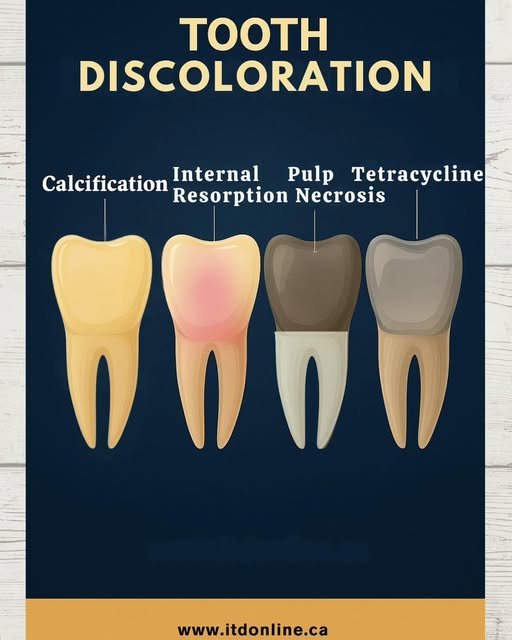From Pain to Perfect — We Care for Your Smile.
Understanding Tooth Discoloration - What the Color of Your Teeth Reveals About Dental Health
Language :

Topics:
Tooth discoloration is more than just a cosmetic issue — it can also be a sign of deeper dental problems. While some stains come from food and drinks, others originate from inside the tooth, linked to conditions such as calcification, internal resorption, pulp necrosis, or even tetracycline staining. Each color change tells a different story about what’s happening within your teeth.
1. Tooth Calcification — Yellow to Creamy White Discoloration
What Happens:
Tooth calcification occurs when the pulp (nerve area) inside the tooth becomes smaller or hardened due to aging, trauma, or natural mineral buildup. This reduces blood supply to the tooth.
Color Analysis:
-
Tooth turns yellowish or opaque white
-
May appear duller or less translucent than nearby teeth
Associated Problems:
-
Usually no pain at first
-
Indicates reduced pulp activity or past trauma
-
Can make teeth brittle over time
Treatment:
Professional whitening may help improve appearance, but severe cases might need a veneer or crown to restore natural color and structure.
2. Internal Resorption — Pinkish to Reddish Discoloration
What Happens:
Internal resorption occurs when the body’s own cells start breaking down the inner walls of the tooth. This often follows trauma or infection that triggers the body’s immune response.
Color Analysis:
-
Tooth may appear pink or reddish from the inside
-
The pink spot often becomes more visible over time
Associated Problems:
-
Possible sensitivity or mild pain
-
Weakening of internal structure leading to potential tooth fracture
Treatment:
A root canal treatment is required to remove infected tissues and stop the resorption process. Early detection through dental X-rays is crucial to save the tooth.
3. Pulp Necrosis — Gray to Black Discoloration
What Happens:
When the tooth pulp dies due to severe decay or trauma, the dead tissue inside releases pigments that seep into dentin — turning the tooth dark.
Color Analysis:
-
Tooth becomes gray, brown, or black
-
Usually darker than surrounding teeth
Associated Problems:
-
Often accompanied by pain, swelling, or sensitivity to heat
-
May cause abscess formation if untreated
Treatment:
Root canal therapy is essential to remove dead tissue, followed by internal whitening or crown placement for cosmetic restoration.
4. Tetracycline Staining — Grayish or Bluish Bands
What Happens:
Tetracycline, an antibiotic once commonly given to children or pregnant women, binds to developing teeth, causing intrinsic discoloration.
Color Analysis:
-
Gray, blue, or brown horizontal bands across teeth
-
Usually affects multiple teeth symmetrically
Associated Problems:
-
Typically no pain, but significant cosmetic concern
-
Difficult to remove with regular whitening methods
Treatment:
Professional solutions include veneers, crowns, or laser whitening for mild cases.
Final Analysis: The Color Tells the Condition
| Tooth Color | Likely Cause | Pain Level | Treatment Option |
|---|---|---|---|
| Yellow / Creamy White | Calcification | None | Whitening / Veneer |
| Pink / Red | Internal Resorption | Mild | Root Canal |
| Gray / Black | Pulp Necrosis | Moderate to Severe | Root Canal + Crown |
| Blue / Brown Bands | Tetracycline Staining | None | Veneer / Whitening |
Mario’s Journey — From Tooth Discoloration to a Bright Smile Again
Mario, a 38-year-old teacher from Davao, started noticing that one of his front teeth was turning gray. At first, he thought it was just coffee stains, so he brushed harder — but the color only deepened. Soon, he began to feel a dull ache whenever he drank something hot or cold.
Worried, Mario visited his local dental clinic. After an X-ray, the dentist explained that his tooth had suffered pulp necrosis — the nerve inside had died due to an old, untreated cavity. The dark color came from pigments released by the dead tissue inside the tooth.
Mario was shocked but relieved to finally know the cause. The dentist performed a root canal treatment, removing the dead pulp and sealing the tooth. A week later, the tooth was restored with an internal whitening and a ceramic veneer to match the rest of his smile.
After treatment, Mario couldn’t stop smiling. The gray tooth that once embarrassed him was now bright and natural-looking again. He learned that even a small color change could mean something deeper — and that early dental visits can save not only your tooth, but also your confidence.
Final Advice
Never ignore a tooth that changes color — it may indicate infection, nerve damage, or past trauma. Regular dental check-ups and X-rays can help identify the cause early, saving your tooth from further damage.




